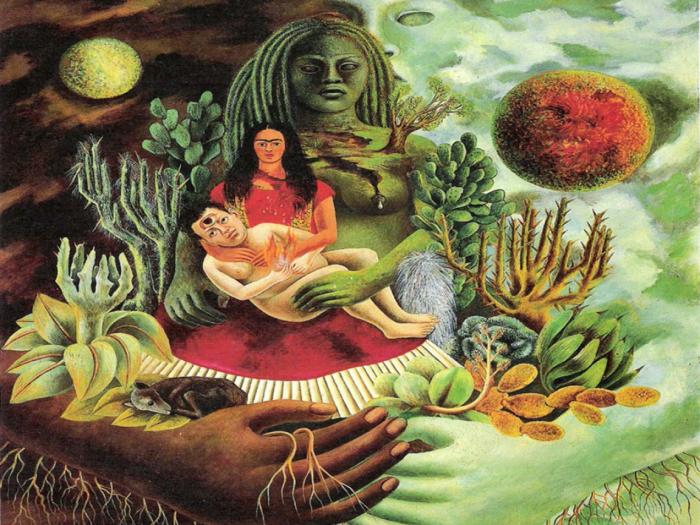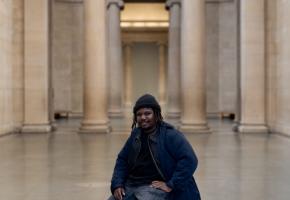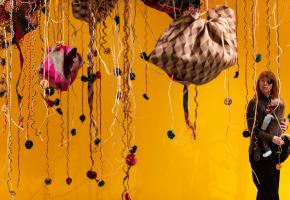Frida Kahlo
Mexican- born Frida Kahlo is undoubtedly one of the most fascinating female artists in the world. Few can fail to be impressed by her passionate, deeply touching paintings through which she channeled her physical and emotional pain, as well as love, tenderness, confusion and fear. This mixture of emotions is blended with vibrant colours and numerous allusions to folk Mexican art. The main subject of her art is herself, her emotional state, reflections about the world that surrounds her. "I paint myself because I am so often alone and because I am the subject I know best."
Her life, and hence her art, were marked by the tempestuous relationship with muralist Diego Riviera and a tram accident that left her crippled, caused constant physical pain and to her great despair made her unable to get pregnant. This didn’t suppress her jovial spirit, love of colourful clothes and jewelry, and her passion. Her life-story was depicted in a must-see biographical film titled “Frida” with an excellent role of Salma Hayek.
.png)
Remedios Varo
Remedios Varo was an exceptionally talented Spanish – born, but Mexican-based painter whose work is a fascinating travel into the world of dreams, emotions, symbols and the subconscious. Her paintings are dominated by mysterious, androgynous characters with almond-shaped eyes often involved in scientific, magic-related activities. The person who supported her artistic development from her early age was her father, a hydraulic engineer. If you have a close look at her paintings you will see that she often depicts water pipes and weird constructions. Another person who strongly influenced her was Salvador Dali, whom she met while studying at San Fernando Academy in Spain. He actually inspired her to become a surrealist painter. During Spanish Civil War she was granted asylum in Mexico. There she met Diego Riviera, Frida Kahlo and Leonora Carrington, who became her close friend. Remedios Varo together with Leonora Carrington not only shared similar artistic styles and imagination, but also sense of humour. They would invite strangers to dinner choosing them randomly from the phone book or serve weird culinary experiments, such as omelet made with human hair, to their guests.

Leonora Carrington
And now a little British accent! Leonora Carrington was a British–born surrealist painter, who spent almost entire life in Mexico. She was rebellious from an early age and got expelled from several schools for her behavior. She began smoking at the age of 11, and never stopped, which can be quite surprising considering she died at the age of 94. Unlike her best friend Remedios Varo, she couldn’t count on much encouragement and support from her family. Her father opposed her idea to become a painter so much that he forbade her to visit him again. Fortunately she found someone who helped her develop artistically. It was Max Ernst, a pioneer of surrealism and the Dada movement, who became her partner. At the beginning of the Second World Was Max was arrested by the French authorities, which led Leonora to a severe nervous breakdown. She was subsequently hospitalized in Spain from where she fled to Mexico. Carrington and Ernst reunited but couldn’t recreate their relationship. Finally she married a photographer Imre Weisz and had two sons. In Mexico she got very inspired by pre Colombian civilizations, mythologies and the occult which significantly enriched her art. According to Elena Poniatowska: "Smoking, drinking English tea — in her kitchen there is a photo of Lady Di — you feel a bit like you're in England when you're with her. But she loves Mexico deeply. Her son Pablo says she wouldn't be who she is without Mexico."
.jpg)
María Izquierdo
This Mexican-born artist is known as the first Mexican female to have her work exhibited in the US. She was raised in a very Catholic family, forced into marriage at the age of fourteen, and by the time she was seventeen she already became a mother three times. She was an autodidact. Her growing passion for painting made her decide to leave her husband and devote herself to art. Her work is classified by some as surrealism, although she never recognized herself as surrealist painter. As a main topic she chose still-lifes, portraits of women, altars and circus scenes.
.jpg)
Ana Mendieta
Ana Mendieta was a Cuban – born artist who emigrated to USA in 1961 through Operation Pedro Pan, which permitted around 14,000 children to legally and safely leave the communist island. She was separated from her family and shunted from one foster home to another. She felt a foreigner, a stranger practically everywhere. This feeling of exile, isolation, longing for her homeland together with a fierce independence of spirit and strong conviction about the power of the femininity influenced her art significantly.
Like Frida, Ana Mendieta is famous for self-portraits, or rather silhouettes of her body incised in clay, carved into rock, made of twigs, leaves or flowers, drench with red paint, blood and consumed by flames or advancing waves. She wanted to make the viewer reflect on female beauty and power, male violence and such concepts as life, death or spiritual transformation. Mendieta evoked the concept of Mother Earth (inspired by Mexican Coatlicue, Atabey worshiped by Taíno people, inhabitants of pre-Columbian Cuba). She often alluded to Santeria, syncretizing African and Catholic elements. Through art she expressed her belief “in one universal energy which runs through everything". She died falling out of the window of her Greenwich Village apartment. Her husband minimalist sculptor Carl Andre was accused of a murder, but in consequence, due to sloppy police and prosecutorial work, he was acquitted of all the charges. The real cause of her death is cloaked in mystery till today.

Maria Magdalena Campos-Pons
Maria Magdalena Campos-Pons is Boston-based Cuban artist inspired by the spiritual traditions of her Yoruban, Hispanic and Chinese ancestors is known for a large-scale Polaroid photographs and multi-media installations. The subjects she addresses are a relationship with her mother, family issues, exile, the sugar industry and slave trade in Cuba.

Anita Malfatti
Anita Malfatti is Brazilian painter considered a pioneer in introducing European influences to Brazilian modernism. Her work raised many controversies and was strongly criticized by the public, mainly because it wasn't related to Brazilian nationalism and traditions. Her artwork was viewed with such a distaste also because she was a woman and at the same time the only Brazilian Avant-garde artist mixing impressionism, post -impressionism, cubism and expressionism.

Tarsila do Amaral
Personally I am not a great fun of her work. It would be unfair though not to recognise her as one of the most prominent female Latin American artists. Tarsila was a Brazilian painter who combined local influences with international avant-garde aesthetics she became familiar with in Paris. Tarsila do Amaral’s paintings depict both people and landscapes reduced to their essential outlines and basic forms. Her best known work is probably Abaporú , which in the Tupí-Guraraní language means “Man Who Eats”. It depicts a human figure with a huge foot seated next to a cactus under a burning sun.

Doris Salcedo
Doris Salcedo is Colombian – born sculptor whose work reflects the unsettled political situation in her homeland, addresses the question of memory and pays homage to the victims of the Civil War in Colombia, using ordinary household items, such as furniture or clothing. Among her most interesting, renown works of art are: Unland: The Orphan’s Tunic La Casa Viuda series and Shibboleth III exhibited in Tate Modern.

Tina Modotti
Tina Modotti is another foreigner who develops artistically in Latin America. Known for her beauty Italian-born modernist photographer led one of the most fascinating lives of her era. She was silent film actress, model, muse, relief worker, a member of Communist Party and Stalinist agent, a friend of Pablo Neruda and Frida Kahlo, a lover of Diego Rivera, Edward Weston and Julio Antonio Mella, who was murdered in her presence. Tina became then a prime suspect. She was eventually acquitted, but sent to exile which led her to Berlin, Moscow, and Paris. She worked in Red Cross and participated in Spanish Civil War. Tina came back to her beloved Mexico for a short time and died at the age of 45 in result of a mysterious heart attack when going back home from a party at Pablo Neruda´s house. It is actually quite surprising that there is still no film about her life…


















